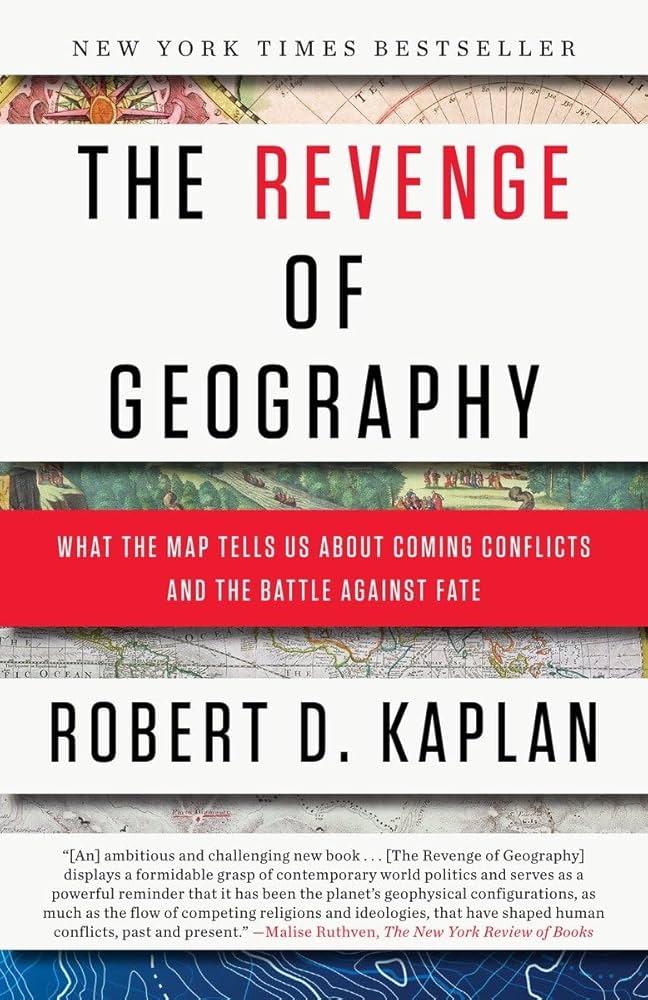
Revenge of Geography by Robert Kaplan provides an ambitious and multifaceted examination of how geography has historically shaped and continues to shape the political landscapes of nations.
The Revenge of Geography: What the Map Tells Us About Coming Conflicts and the Battle Against Fate by Robert Kaplan provides an ambitious and multifaceted examination of how geography has historically shaped and continues to shape, the political landscapes of nations. Kaplan argues that physical geography is a powerful force in determining the paths nations take—both in terms of foreign policy and internal cultural dynamics. Through a series of chapters that explore the major geopolitical theories and their historical roots, Kaplan invites readers to consider geography as a constant yet subtle influence on national destinies. For readers new to international relations, the book serves as an engaging entry point to key theories like Mackinder’s Heartland theory and Spykman’s Rimland theory, elucidating these complex ideas in a way that balances accessibility with depth.
Kaplan’s writing style is simultaneously analytical and narrative, appealing to students and professionals in international relations alike. While the language can feel dense at times, especially for readers unfamiliar with the subject, it rewards persistence. His explorations of Western geopolitical theories are comprehensive and make the book particularly useful as a reference. Seasoned readers will find Kaplan’s synthesis of historical context and geopolitical analysis thought-provoking, while newcomers may appreciate how the book’s structure introduces them to important figures and theories in international politics.
However, Revenge of Geography does reflect a noticeable Western bias, focusing heavily on Europe, Russia, and the United States. Kaplan often relies on theories and insights from Western scholars, such as Mackinder, Mahan, and Spykman, making his perspective feel somewhat limited to a Eurocentric framework. He often prioritizes Western historical events and viewpoints, with particular emphasis on the fall of the Berlin Wall and the evolution of U.S. foreign policy. The chapters on India and parts of Asia bring some balance by addressing non-Western perspectives, yet they are few and relatively short compared to the treatment given to Western subjects. For example, regions such as Africa, South America, and the Nordic countries receive minimal coverage, despite their rich histories and current geopolitical importance.
Kaplan argues that physical geography is a powerful force in determining the paths nations take—both in terms of foreign policy and internal cultural dynamics.
The chapter “India and Its Geopolitical Dilemma” is one of the standout sections of the book. Here, Kaplan takes a more balanced approach, acknowledging India’s unique challenges and opportunities shaped by its geography. This chapter dives into India’s history with an appreciative view of its cultural and geopolitical significance, examining the subcontinent’s diverse landscape and how it has influenced the nation’s development. Unlike other sections where Kaplan’s Western-centric lens dominates, this chapter explores India’s role in a nuanced and respectful manner, drawing attention to the subcontinent’s rich historical context without undermining its complexity. Readers interested in South Asia will find this part both informative and balanced, adding valuable context to India’s current strategic position in global politics. This treatment is unfortunately not extended to other non-Western regions in the book, leaving some aspects of global geography underexplored.
In contrast, Kaplan’s chapter “Herodotus and His Successor” may prove less engaging to readers, as it delves into ancient perspectives on geography with a dry, academic tone that doesn’t match the accessibility of other chapters. The historical lens here, while valuable, can feel overly abstract, with Kaplan taking a more didactic approach that may feel disconnected from the book’s more narrative-driven sections. This chapter’s focus on ancient historical perspectives is insightful but may lose the interest of readers who are more engaged with contemporary geopolitical concerns.
Kaplan’s intellectual honesty adds depth to the book, encouraging readers to view Western policies more objectively, often challenging Western assumptions about moral superiority in international affairs.

Another recurring critique of the book is Kaplan’s frequent reliance on certain figures, particularly Alfred Thayer Mahan, the American naval historian. Kaplan’s admiration for Mahan’s theories on sea power is clear, but his repeated mentions may feel excessive and potentially detract from other perspectives. In the chapter “The Allure of Sea Power,” Kaplan’s constant references to Mahan sometimes overshadow other relevant discussions. While Kaplan’s analysis of Mahan’s theories is thorough and well-researched, readers may find the constant repetition somewhat tedious, feeling as though Kaplan is overly enamoured with Mahan’s contributions. By placing greater emphasis on diverse thinkers and a wider array of global perspectives, Kaplan could have enriched his analysis and provided readers with a broader understanding of maritime and continental strategies alike.
Kaplan does, however, show commendable intellectual honesty in his critique of Western policies. He frequently challenges Western assumptions, even quoting influential thinkers like Hans Morgenthau, who argued that democracies are not inherently more moral in their foreign policies than autocracies. This critical stance adds depth to the book and encourages readers to view Western policies more objectively. Kaplan’s inclusion of other voices, like William McNeill, who acknowledges India’s cultural and religious history without adopting a superior tone, adds a refreshing layer to the book’s narrative. McNeill’s observation about how the Indian subcontinent’s geography influenced a unique cultural personality in the Gangetic plains serves as an example of the book’s thoughtful, if sporadic, consideration of non-Western perspectives. Still, this more balanced view appears only occasionally, leaving readers wanting more consistent engagement with voices from Asia, Africa, and Latin America.
Despite its Western-centric focus and occasional redundancy, the book offers valuable perspectives and remains a foundational resource for anyone looking to deepen their understanding of how the physical world shapes human ambitions.
In the later chapters, Kaplan delves into the geopolitics of Russia, Iran, the Ottoman Empire, and the USA-Mexico dynamic, exploring how these regions have been shaped by their respective geographies. Kaplan is thorough in discussing how Russia’s vast landmass has influenced its security concerns and imperial history, while his analysis of Iran and the Ottoman Empire showcases how natural borders and deserts have acted as both protection and limitation. These chapters are particularly engaging and contribute to Kaplan’s overall thesis that geography imposes specific constraints and opportunities on a nation’s political ambitions. The author could have improved this analysis by integrating more insights into the geopolitical shifts in African, South American, and Nordic regions, which are touched upon but not given the same depth as the Middle Eastern and European chapters. This oversight leaves out critical players whose roles in today’s geopolitical arena are substantial, making the analysis feel incomplete at times.
Kaplan also addresses contemporary shifts in global power dynamics, citing Bracken’s view on Asia’s resurgence as a single organic unit and the waning influence of U.S. power. He references Bracken’s observation about the rise of China, India, and other indigenous Asian powers as regional subunits collapse, which adds an interesting dimension to the book’s analysis of Asia. This passage, along with the discussion on India’s geopolitical challenges, exemplifies Kaplan’s skill in identifying emerging trends, though it would have been enriched by including voices from these regions, especially given the current shifts in economic and military power toward Asia.
In conclusion, Revenge of Geography is a highly recommended read for students and professionals in international relations who want a well-researched exploration of geography’s impact on politics and history. Kaplan’s insights into the major geopolitical theories and their historical roots will resonate with readers who are interested in understanding the global forces at play. Despite its Western-centric focus and occasional redundancy, the book offers valuable perspectives and remains a foundational resource for anyone looking to deepen their understanding of how the physical world shapes human ambitions. For readers willing to approach it with an awareness of its limitations, Revenge of Geography is an intellectually stimulating journey that provides much to ponder about the enduring influence of geography on global politics.
(Manish Sharma is pursuing a master’s in international relations at Jindal School of International Affairs. His areas of interest include foreign policy, geopolitical analysis and current affairs and contributes regularly on these topics. Views expressed are the author’s own.)
Book: The Revenge of Geography: What the Map Tells Us About Coming Conflicts and the Battle Against Fate
Authors: Kaplan, Robert D.
Publishers: RHUS
Price: ₹ 427 (Paperback)
SW Ratings: ***1/2
